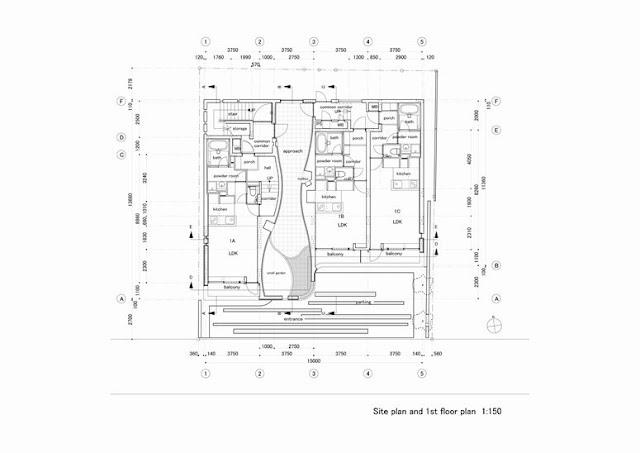Kyoto, Japan
EASTERN Design Office
Post By:Kitticoon Poopong
 |
| Photo © Courtesy of Koichi Torimura |
The site is in Nishioji-hachijo, Kyoto. From the main street we enter into a covert place along an alley of 4 meters in width.
 |
| Photo © Courtesy of Koichi Torimura |
 |
| Photo © Courtesy of Koichi Torimura |
This construction is a collective housing consisting of 11 units. The impersonality of segmental housing complex is completely concealed in this architecture. Instead it is built to be seen as one big house.
 |
| Photo © Courtesy of Koichi Torimura |
The architecture is covered with a wall in which holes are cut. The shape of the holes resembles a trunk, leaves, a root and bulbs. It also can be seen as clouds floating over the trees.
 |
| Photo © Courtesy of Koichi Torimura |
 |
| Photo © Courtesy of Koichi Torimura |
Concrete shape which is based on nature turns into a hollow cave, light, and sunbeams filtered through trees.
The idea of windows like sunbeams filtered through trees has developed with the following methods: lined up
balconies of average collective housing are completely hidden here ・ there is no balcony for each room ・ the ceiling height of one room is raised ・ dwelling units are elevated one meter from the ground ・ floor level of entrance and apartments is different・ center of the wall surface is curved ・ the center of the façade of the architecture is sculptured ・ a curved winding slit is made on the curved wall surface ・ the shape of the holes matches with the winding slit ・ the result is one shape of a plant growing roots undulating from it.
 |
| Photo © Courtesy of Koichi Torimura |
 |
| Photo © Courtesy of Koichi Torimura |
Since curved holes are made on a carved wall surface, it is physically inevitable that the section of holes is also twisted. This distortion resembles the shape of plants and the organic and free style of nature.
 |
| Photo © Courtesy of Koichi Torimura |
 |
| Photo © Courtesy of Koichi Torimura |
The entrance to the house is from the root carved into the center of the front wall. An inner pathway peculiar to Kyoto can be found there. An inner pathway is a narrow corridor which runs from street to street and from lot to lot.
 |
| Photo © Courtesy of Koichi Torimura |
In this project the inner path is connected to the garden of the town house of the client. He manages this collective housing by himself. It is his daily routine to do sweeping, arranging flowers at the entrance, and watering the path. Thus he enjoys his post-retirement years.
 |
| Photo © Courtesy of Koichi Torimura |
 |
| Photo © Courtesy of Koichi Torimura |
This land was once the site of NIshihachijo-palace, which was the residence of a hero of the Japanese classical tragedy, “Tale of Heike.” It was a stage of rise and fall of a clan in the 12th century. Such an old and sad memory is cherished and still told among the people of this neighborhood.
 |
| Photo © Courtesy of Koichi Torimura |
The collective housing that is built on such a historical place should not be seen as an average apartment house. Such notion occurred to us, which might have led us to the idea of an “immortal tree.”
 |
| Photo © Courtesy of Koichi Torimura |
We, therefore, designed a building which does not take vaguely a shape of a tree, but rather an intense and massive form with a tint of movement.
 |
| Photo © Courtesy of Koichi Torimura |
The lot size is 16m×19m. This architecture gives an answer how to build a low collective housing in a quiet but dense place.
 |
| Photo © Courtesy of Koichi Torimura |
What does the name Saitan mean? Tan is the color of the shrine gates, vermilion. It is also the color of pale red granite stone. Vermilion will not be weathered. It is said that vermillion is a sacred color and it used to be applied on serving dishes and bow and arrow to make them holy ones. Sai means variety of beautiful colors that make something more attractive.
 |
| Photo © Courtesy of Koichi Torimura |
 |
| Photo © Courtesy of Koichi Torimura |
 |
| Photo © Courtesy of Koichi Torimura |
 |
| ground floor plan--drawing Courtesy of EASTERN Design Office |
 |
| wall axo--drawing Courtesy of EASTERN Design Office |
 |
| wall detail 01--drawing Courtesy of EASTERN Design Office |
 |
| wall detail 02--drawing Courtesy of EASTERN Design Office |
The people
Architects: EASTERN Design Office + HOJO Structure Research Institute
Location: Kyoto, Japan
Client: Shigekazu Yagi
Constructor: Minobe Construction Corporation
Site Area: 301.82 sqm
Total Floor Area: 557.70 sqm
Project Year: 2006
Photographs: Koichi Torimura
via:archdaily

























